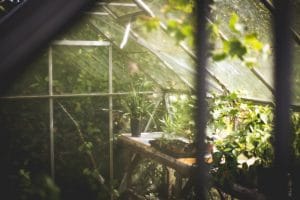How to Lower Humidity in a Greenhouse

Greenhouses are very convenient and offer several great benefits. They allow you to start seeds earlier, produce larger yields, and increase the length of growing seasons. Greenhouses offer an enclosed setting for growing and the use of focused sunlight for an ideal grow site. However, humidity control can be an ongoing problem.
Humidity’s Effect on a Greenhouse
Depending on what types of plants grow in your greenhouse, humidity can be a necessity. For instance, if you grow a lot of tropical plants, they need humidity to thrive. Alternatively, some plants can die from too much humidity because they will mildew and rot. Hence, it’s vital to carefully balance the right amounts of ambient moisture for your plant types.
What Causes Humidity in a Greenhouse?
Greenhouse humidity is caused by condensation. Condensation is caused when moisture, closed spaces, and warm temperatures are combined. So, in this setting, it occurs when the exterior of the enclosed structure is struck with high temperatures. The only factor you can control in this situation is the moisture. We’re going to tell you how to control that moisture.
How to Lower Humidity in a Greenhouse
It can be tricky setting up your humidity control system at first. You can go about it many ways, so it comes down to finding the way that works best for you. Let’s take a look at the best ways.
Good Air Circulation
Keeping proper air circulation is important for controlling ambient moisture. This can be done through the use of fans, vents, and the right spacing of plants. Your greenhouse should also have adequate ventilation, as this will replace moist air with air that’s dryer and cooler.
Adjust Temps for Nighttime
At nighttime, you should lower heater temperatures because this will help prevent condensation. You can also invest in a good humidistat to help keep air moisture at acceptable levels.
Prevent Standing Water
An easy way to help lower humidity is by making sure there is no standing water present. This is because any form of water sitting around will be evaporated into the air and form droplets. Most experts agree that using a drip irrigation system is wise because these systems send water to the roots only, thus keeping moisture down. It can also help keep the plant leaves dry, and this is important because fungal pathogens like to breed there. When it comes to watering the plants, it’s best to do so early in the morning because it will help excess moisture evaporate more quickly.
Use Desiccants
Many commercial humidity control systems use desiccants to capture moisture from the air. These desiccants can be purchased wholesale directly from adsorbent suppliers. Depending on the size of your greenhouse, you may be able to use desiccants on their own. If you strategically place the desiccants, they can automatically pull the moisture from the air without having to direct air flow.
Keep your greenhouse green! Purchase desiccants at wholesale for your humidity control system.
